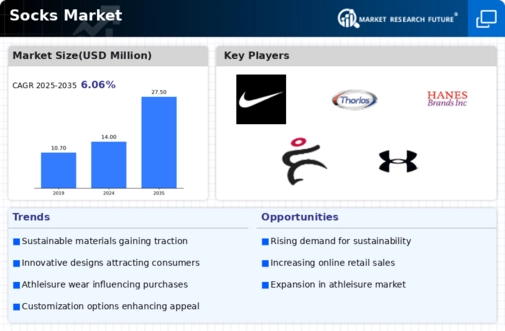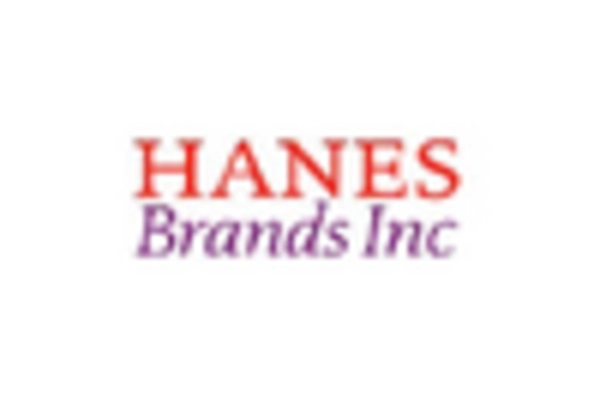Market Trends
Introduction
In 2023, the Socks Market is experiencing a significant transformation in the wake of several macroeconomic factors. Materials and manufacturing processes are increasingly enhancing the performance and sustainability of products, and responding to the growing demand for eco-friendly products. Meanwhile, changes in the behavior of consumers, such as the rise of athleisure and the emphasis on comfort, are reshaping the product portfolio and marketing strategies. The regulatory frameworks relating to the conditions of work and the environment are also affecting the industry’s business practices. These are the trends that companies must understand in order to align their product development and marketing strategies with the expectations of consumers and the regulatory framework, and to ensure their competitiveness in a rapidly changing market.
Top Trends
-
Sustainability and Eco-Friendly Materials
The demand for sustainable socks is growing. Brands like Adidas are leading the way, making socks out of recycled materials. A survey showed that 66% of consumers prefer brands that are socially responsible. This is leading producers to invest in more sustainable manufacturing methods, which could transform the supply chain. Biodegradable materials and circular economy practices may be on the horizon. -
Smart Socks Technology
Wearable health sensors are gaining ground, and a number of companies, including Under Armour, have already introduced performance-tracking smart socks. The research suggests that the market for wearable devices will continue to grow, and that the market for socks will be affected. This trend could result in the sock manufacturers forming alliances with technology companies, which would then enhance the socks’ functionality. This could include a fitness app, a personal health tracker and even health insights. -
Athleisure and Fashion-Forward Designs
Sporty lines like those from Nike and the like continue to dominate the market. The popularity of athleisurewear is said to have had a major influence on the popularity of fashionable and practical socks. The trend has also made it possible for sportswear companies to work with fashion designers, thus expanding their markets. More limited-edition lines and collaborations with fashion influencers are expected to be forthcoming. -
Increased Focus on Comfort and Performance
Thorlo focuses on cushioning and moisture transport. It is found from consumer feedback that 7 out of 10 people buy socks for comfort. This trend has led to the sock industry enhancing product features and thereby increasing production costs. The future may bring about a development of socks designed for particular activities, such as running or hiking. -
Customization and Personalization
The same thing is happening with socks. There are a growing number of companies offering to make custom-designed socks for individual preferences. A survey has found that half of consumers are willing to pay more for a product that has been made to their own specifications. This trend is encouraging companies to invest in on-demand production technology, which could cut production costs. Artificial intelligence-based design tools could help consumers create their own unique sock styles. -
Health and Wellness Integration
A sock designed for a specific purpose, such as compression socks, is on the rise. One of the companies that has mastered this niche is Balega. The research shows that the global market for compression socks is growing, which reflects the growing health consciousness of consumers. This trend has prompted the brands to diversify their products, which may lead to an increase in market competition. In the future, there may be a possibility of collaborating with medical professionals to promote these products. -
Subscription Services and Direct-to-Consumer Models
Subscriptions to socks are changing the way we shop. Brands offer monthly deliveries. Data shows that in the last few years, the number of subscriptions has increased by 200%. This trend is causing brands to increase customer loyalty through personalisation. Subscriptions can be offered on different levels with exclusive benefits for members. -
Global Expansion and Emerging Markets
Brands are increasingly concentrating on emerging markets, with companies like Hanesbrands expanding their distribution in Asia. The demand for good socks in these countries is rising, according to market research. This development is causing brands to adapt their marketing to the preferences of the local population. Localized product ranges and regional retailing may be in the offing. -
Innovative Marketing Strategies
It is therefore essential to use creative means of communication. Brands are deploying social media influencers to reach younger audiences. A survey has shown that 70% of millennials are influenced in their purchasing decisions by social media. This trend is driving brands to invest in digital marketing, which can increase brand visibility. Future developments may include augmented reality experiences for virtual fittings. -
Enhanced Durability and Performance Features
Drymax is a brand that emphasizes the properties of its products and the strength of its materials. According to a study, 80% of consumers consider the quality of the product as an important purchase criteria. This trend encourages innovation in material science and, possibly, increases production costs. The next step could be the introduction of a guarantee or a period of use.
Conclusion: Navigating the Competitive Socks Landscape
In 2023, the sock market will be extremely competitive and very fragmented, with both established and new players vying for consumer attention. The growing preference for sustainable and innovative products will force the suppliers to change their strategies. Brands will build on their established brand equity and will use automation and artificial intelligence to increase operational efficiency and improve customer engagement. Meanwhile, newcomers will bet on agility and sustainability to gain a foothold in the crowded marketplace. These new capabilities in artificial intelligence, automation, agility and sustainability will be the key to leadership and will force the suppliers to rethink their strategic positioning in order to remain relevant and competitive.









Leave a Comment